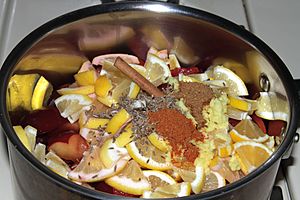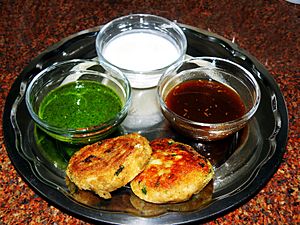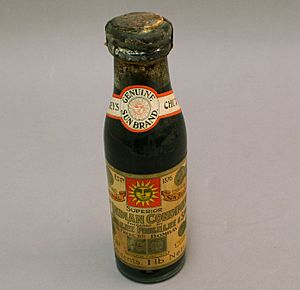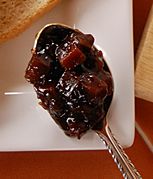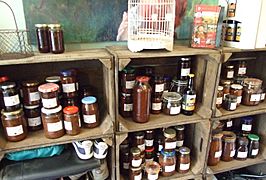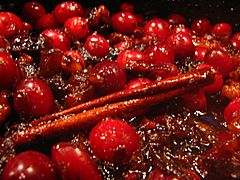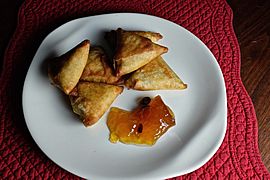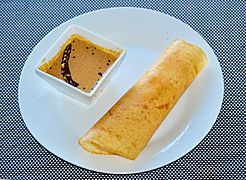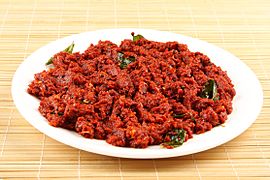List of chutneys facts for kids
Chutney is a super tasty sauce or condiment that comes from India. It's popular in countries like India and its neighbors. People make chutney from all sorts of spices, vegetables, or fruit. It's a bit like a relish or pickle. Chutneys are now made in big factories, so you can find them easily in stores!
Popular Chutney Types
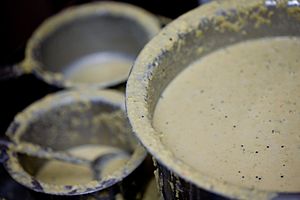
Fresh coconut chutney
- Blatjang — This is a chutney from South Africa. It's made using dried fruits.
- Branston Pickle — This famous jarred chutney was first made in England in 1922. It's sweet and spicy, with chunks of vegetables in a thick brown sauce.
- Chammanthi podi — A dry coconut chutney from Kerala, a state in India.
- Coconut Chutney — A common side dish in South India. It's made by grinding coconut pulp with ingredients like tamarind, green chili, and coriander.
- Coriander Chutney — This chutney is very common in Indian cooking.
- Dahi Chutney — Made by mixing strained yogurt with mint and onions. It's popular in South India.
- Eromba — A special chutney often found in Manipuri cuisine from India.
- Garlic Chutney — Made with fresh garlic, dry or fresh coconut, and chili peppers. It can be wet or dry.
- Gooseberry Chutney — Also called "amlakir chutney," it's popular in Bengali cuisine. It's made by boiling gooseberries in a sweet syrup.
- Green Mango Chutney — An Indian chutney made from unripe mangoes.
- Hara Choley Chutney — Made with raw, unripe green chickpeas. It's often mixed with green coriander leaves.
- Hog Plum Chutney — Common in Bengali and Karnataka cooking. In West Bengal, it's called "Amrar chutney."
- Kachri ki Chutney — This chutney is made using kachri, which is a type of wild melon.
- Major Grey's Chutney — This chutney is said to be named after a British Army officer from the 1800s. It's known for being milder than other chutneys.
- Mango Ginger Chutney — A Bengali chutney made with mango ginger (amada) and tamarind paste. People often eat it with snacks like samosa.
- Papaya Chutney — A common chutney in Bengali cuisine, sometimes called "plastic chutney." It's made by boiling green papaya with sugar and lemon juice.
- Peanut Chutney — A mildly spicy chutney that goes well with many different foods.
- Pineapple Chutney — Known as "anaras er chutney" in Bengali cuisine. It's made by boiling thin slices of pineapple in sugar syrup.
- Pudina Chutney — This chutney is made using mint.
- Ridge Gourd Chutney — Part of Udupi cuisine in India. It's eaten with meals or snacks like dosa or idli.
- Saunth — A sweet chutney used in Indian chaats. It's made from dried ginger (sooth) and tamarind (imli) paste.
- Tamarind Chutney — Also called imli chutney. It's used with many Indian snacks like samosa and kachori.
- Tomato Chutney — A chutney made mainly from tomatoes. Tamtar kasundi is a spicy tomato and mustard chutney from Bengal. Tomato chutney was also made in large amounts in the United States in the late 1800s.
Chutney Pictures!
See also

All content from Kiddle encyclopedia articles (including the article images and facts) can be freely used under Attribution-ShareAlike license, unless stated otherwise. Cite this article:
List of chutneys Facts for Kids. Kiddle Encyclopedia.

